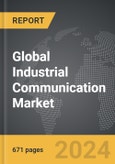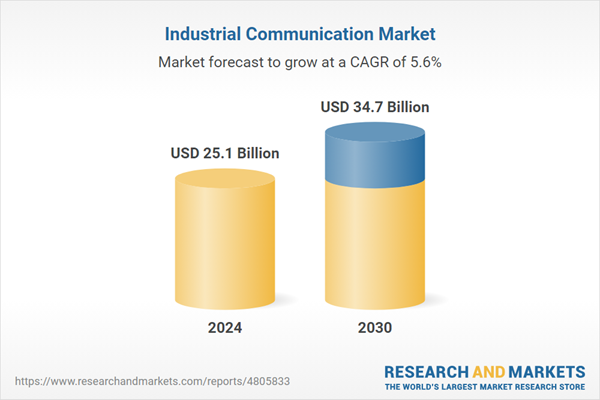Global Industrial Communication Market - Key Trends & Drivers Summarized
How Is Industrial Communication Transforming Manufacturing and Automation?
Industrial communication is revolutionizing manufacturing and automation by enabling seamless connectivity and data exchange between machines, systems, and operators. This technology facilitates real-time monitoring, control, and optimization of industrial processes, enhancing efficiency, productivity, and flexibility. Industrial communication networks, including Ethernet, wireless, and fieldbus systems, support various protocols and standards to ensure reliable and secure data transmission in harsh industrial environments. The integration of industrial communication with IoT and Industry 4.0 technologies is driving the development of smart factories, where interconnected devices and systems work collaboratively to improve operational performance and reduce downtime.What Are the Benefits and Challenges of Implementing Industrial Communication Systems?
The implementation of industrial communication systems offers significant benefits, including improved process control, increased productivity, and enhanced safety. These systems enable real-time data collection and analysis, allowing operators to make informed decisions and quickly respond to issues. Industrial communication also supports predictive maintenance, reducing equipment failures and extending asset lifespan. However, challenges include the complexity of integrating various communication protocols and ensuring compatibility between different devices and systems. Cybersecurity is another critical concern, as industrial networks are vulnerable to cyberattacks. Addressing these challenges requires robust network management, adherence to industry standards, and continuous investment in cybersecurity measures.How Are Technological Advancements Enhancing Industrial Communication?
Technological advancements are significantly enhancing industrial communication, making networks more reliable, secure, and efficient. The development of industrial Ethernet and wireless communication technologies is providing high-speed, low-latency connectivity for real-time data exchange. Advances in IoT and edge computing are enabling distributed intelligence, where data is processed closer to the source, reducing latency and bandwidth requirements. Enhanced cybersecurity solutions, including encryption, authentication, and anomaly detection, are protecting industrial networks from cyber threats. The adoption of open standards and interoperability frameworks is ensuring seamless integration of diverse devices and systems, facilitating the development of flexible and scalable industrial communication networks. These technological improvements are driving the evolution of smart manufacturing and automation.What Factors Are Driving the Growth in the Industrial Communication Market?
The growth in the industrial communication market is driven by several factors. The increasing adoption of automation and digitalization in manufacturing and process industries is a primary driver, necessitating robust and reliable communication networks. Technological advancements in communication protocols and cybersecurity are enhancing the functionality and security of industrial networks. The rise of IoT and Industry 4.0 is boosting demand for interconnected devices and systems, further driving the need for advanced industrial communication solutions. Additionally, government initiatives and investments in smart infrastructure and manufacturing are supporting market growth. The growing focus on operational efficiency, predictive maintenance, and real-time data analytics is also contributing to the expansion of the industrial communication market. These factors collectively ensure the sustained growth and innovation in the industrial communication market.Report Scope
The report analyzes the Industrial Communication market, presented in terms of units. The analysis covers the key segments and geographic regions outlined below.Segments: Offering (Hardware, Software, Services); Protocol (Industrial Ethernet, Fieldbus, Wireless); Vertical (Automotive, Electrical & Electronics, Aerospace & Defense, Oil & Gas, Energy & Power, Food & Beverage, Pharmaceuticals & Medical Devices, Other Verticals).
Geographic Regions/Countries: World; USA; Canada; Japan; China; Europe; France; Germany; Italy; UK; Spain; Russia; Rest of Europe; Asia-Pacific; Australia; India; South Korea; Rest of Asia-Pacific; Latin America; Argentina; Brazil; Mexico; Rest of Latin America; Middle East; Iran; Israel; Saudi Arabia; UAE; Rest of Middle East; Africa.
Key Insights:
- Market Growth: Understand the significant growth trajectory of the Industrial Ethernet segment, which is expected to reach US$20.1 Billion by 2030 with a CAGR of a 5.4%. The Fieldbus segment is also set to grow at 5.6% CAGR over the analysis period.
- Regional Analysis: Gain insights into the U.S. market, valued at $3.7 Billion in 2024, and China, forecasted to grow at an impressive 7.0% CAGR to reach $7.0 Billion by 2030. Discover growth trends in other key regions, including Japan, Canada, Germany, and the Asia-Pacific.
Why You Should Buy This Report:
- Detailed Market Analysis: Access a thorough analysis of the Global Industrial Communication Market, covering all major geographic regions and market segments.
- Competitive Insights: Get an overview of the competitive landscape, including the market presence of major players across different geographies.
- Future Trends and Drivers: Understand the key trends and drivers shaping the future of the Global Industrial Communication Market.
- Actionable Insights: Benefit from actionable insights that can help you identify new revenue opportunities and make strategic business decisions.
Key Questions Answered:
- How is the Global Industrial Communication Market expected to evolve by 2030?
- What are the main drivers and restraints affecting the market?
- Which market segments will grow the most over the forecast period?
- How will market shares for different regions and segments change by 2030?
- Who are the leading players in the market, and what are their prospects?
Report Features:
- Comprehensive Market Data: Independent analysis of annual sales and market forecasts in US$ Million from 2024 to 2030.
- In-Depth Regional Analysis: Detailed insights into key markets, including the U.S., China, Japan, Canada, Europe, Asia-Pacific, Latin America, Middle East, and Africa.
- Company Profiles: Coverage of players such as AAEON Technology Inc., Advantech Co. Ltd., Beckhoff Automation GmbH and Co. KG, Belden Inc., Bosch Rexroth AG and more.
- Complimentary Updates: Receive free report updates for one year to keep you informed of the latest market developments.
Some of the 112 companies featured in this Industrial Communication market report include:
- AAEON Technology Inc.
- Advantech Co. Ltd.
- Beckhoff Automation GmbH and Co. KG
- Belden Inc.
- Bosch Rexroth AG
- Cisco Systems, Inc.
- Eaton
- Emerson Electric Co.
- Ericsson
- General Electric Company
- Hans Turck GmbH & Co. KG
- Hitachi, Ltd.
- HMS Industrial Networks AB
- Huawei Technologies Co., Ltd.
- IFM electronic GmbH
- Molex, LLC
- Moxa Inc.
- National Instruments Corp.
- OMRON Corporation
- Rockwell Automation, Inc.
- Schneider Electric SE
- SICK AG
- Siemens AG
Tariff Impact Analysis: Key Insights for 2025
Global tariff negotiations across 180+ countries are reshaping supply chains, costs, and competitiveness. This report reflects the latest developments as of April 2025 and incorporates forward-looking insights into the market outlook.The analysts continuously track trade developments worldwide, drawing insights from leading global economists and over 200 industry and policy institutions, including think tanks, trade organizations, and national economic advisory bodies. This intelligence is integrated into forecasting models to provide timely, data-driven analysis of emerging risks and opportunities.
What’s Included in This Edition:
- Tariff-adjusted market forecasts by region and segment
- Analysis of cost and supply chain implications by sourcing and trade exposure
- Strategic insights into geographic shifts
Buyers receive a free July 2025 update with:
- Finalized tariff impacts and new trade agreement effects
- Updated projections reflecting global sourcing and cost shifts
- Expanded country-specific coverage across the industry
Table of Contents
Companies Mentioned (Partial List)
A selection of companies mentioned in this report includes, but is not limited to:
- AAEON Technology Inc.
- Advantech Co. Ltd.
- Beckhoff Automation GmbH and Co. KG
- Belden Inc.
- Bosch Rexroth AG
- Cisco Systems, Inc.
- Eaton
- Emerson Electric Co.
- Ericsson
- General Electric Company
- Hans Turck GmbH & Co. KG
- Hitachi, Ltd.
- HMS Industrial Networks AB
- Huawei Technologies Co., Ltd.
- IFM electronic GmbH
- Molex, LLC
- Moxa Inc.
- National Instruments Corp.
- OMRON Corporation
- Rockwell Automation, Inc.
- Schneider Electric SE
- SICK AG
- Siemens AG
Table Information
| Report Attribute | Details |
|---|---|
| No. of Pages | 671 |
| Published | April 2025 |
| Forecast Period | 2024 - 2030 |
| Estimated Market Value ( USD | $ 25.1 Billion |
| Forecasted Market Value ( USD | $ 34.7 Billion |
| Compound Annual Growth Rate | 5.6% |
| Regions Covered | Global |









